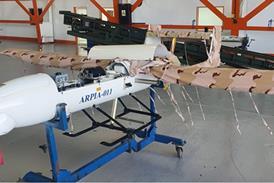David Field WASHINGTON DC
For now, Boeing is leaving the superjumbo market to Airbus, preferring to dream of speed rather than size with the futuristic Sonic Cruiser concept.
In the race between size and speed, the victory goes to the clever. That is the lesson in the latest Boeing boasting match with Airbus over their rival theories of what airlines and passengers want. Both manufacturers start from the premise that the major hubs will remain crowded. Airbus argues that its 550-seat-plus A380 therefore makes the best sense by getting more people onto each aircraft. Boeing argues that passengers want point-to-point operation and to bypass hubs with a faster service.
So this spring Boeing began a campaign for what it calls the Sonic Cruiser, which would be the fastest airliner it has ever built. At speeds of up to Mach 0.98, the Sonic Cruiser could enter service by 2007, far outpacing commercial models now in service that cruise at Mach 0.82.
Seating under 300 passengers - most likely 200 - and with a range of as much as 16,700km (9,000nm), the aircraft would fly at up to 49,000ft (15,000m), reducing flight times by more than one hour for every 5,000km flown. That means trimming a couple of hours from the average transatlantic trip and three hours off a 14-hour transpacific flight. This would potentially avoid a hub change that may currently be necessary, says Boeing airliner president Alan Mullaly.
Both Airbus and Boeing cite evidence of airline support for their particular vision. Airbus expects to have taken orders for the A380 up to the 100 mark by the end of this year.
For its part, Boeing's new project has produced some enthusiastic public interest from airline leaders. At this early stage, and even though they are far from or perhaps never likely to place orders, this is understandable. The relationship between airframers and their customers is unique: the customer is always "a great airline", and the manufacturer always has "great ideas". As luck would have it, the Sonic Cruiser concept was unveiled on the same day as the Star Alliance presidents were holding one of their regular press briefings. United Airlines chief Jim Goodwin seemed genuinely "excited" and others duly followed with diplomatic praise for the concept. Elsewhere, Don Carty at American Airlines says he is interested too.
But the key relationship is that between Airbus and Boeing, and here enters the spoiler theory. Over the pre-launch years in which Airbus was winning front-page coverage with its talk of the A380 (then the A3XX), Boeing had a no-lose strategy. It stayed in the superjumbo game, saying that it would launch a programme if orders were forthcoming while casting doubts that they would. Meanwhile it continued to make excellent profits from the 747-400. When Airbus did risk its billions on the A380, Boeing could simply sit back and watch. But Airbus insists that it will make money on the A380 and adds that talk of it giving away the product echoes the charge made of every new launch.
Now, the theory continues, Boeing is advancing another spoiler, if only to steal headlines before the Paris air show in June. Boeing could use the Sonic Cruiser proposal to string along possible industrial partners and keep them from signing up with Airbus, says Richard Aboulafia, an analyst with the Teal Group. Adding a conspiracy theory to the outflanking theory, Boeing could also use the Sonic Cruiser to distract Airbus with the thought that it too should invest in a high-subsonic transport programme. That may be far too clever, Aboulafia concedes, but Airbus does not rule out a response even if it is still likely to be a decade away.
US aviation consultant John Walsh says the Sonic Cruiser concept can serve as a brilliant visual marketing tool for Boeing's philosophy of market fragmentation. However he is puzzled that it is offering an aircraft that would, barring any sudden breakthrough in engine technology, also be a gas-guzzler.
Boeing marketing vice-president Randy Baseler responds that the Sonic Cruiser's speed would create cost efficiencies in crew and aircraft utilisation that would help balance out the increased fuel burn. He also suggests that the Sonic Cruiser will be so attractive to business travellers that it could command higher yields, again making up for the added fuel costs.
So Airbus is faced with the prospect of determining just how clever Boeing has been, or is going to be. Is its Seattle rival making a feint? And did it make a feint or fake out Airbus when it backed off its own superjumbo and then put on hold the proposed 747X? While theories abound, both manufacturers insist that they are in the business of building and selling airliners. And both Airbus and Boeing insist that the market, in the form of the airlines, will determine what concepts move from the drawing board to the production line.
Source: Airline Business























